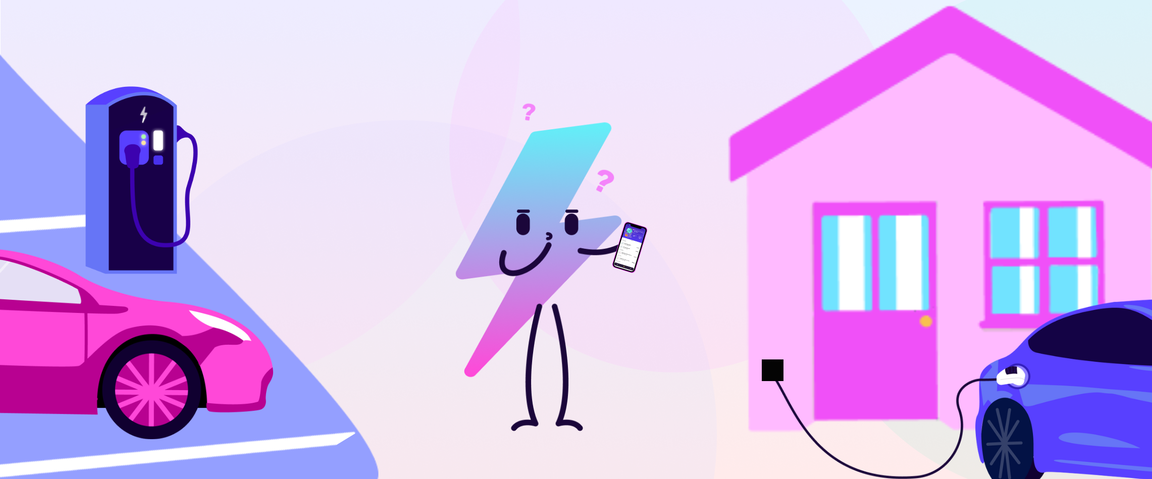April 2022
|Last updated:April 2024
Common EV Misconceptions
Before 2008, electric vehicle functionality wasn't great. Range and battery performance were something of concern, the public charging network didn’t exist, and electric vehicles were far more costly to buy than a petrol or diesel car. Thankfully, that is no longer the case!
Modern EVs rival any petrol or diesel car - from faster acceleration to cheaper running costs, and they come with more 'health and wealth' benefits, as we’ll discuss further down. But because electric vehicle technology has progressed so quickly, its recent history causes common misconceptions.
Misconceptions we're here to BUST.
Let's get plugged in...
EVs have too short a range
Frustratingly, the most common misconception about current electric vehicles is also the primary reason why many people do not make the switch.
Range anxiety in the UK is a frequent worry - even those who do not regularly take long car journeys consider range a key specification when buying an EV.
The fact of the matter is different EVs offer different ranges.
In the UK, electric vehicles have a wide mileage range on offer. While the average journey (via car) is under 7 miles a day, the average mileage of an EV is 174 miles. So unless your work commute is from Glasgow to Blackpool, don't plan on using your EV as an excuse for arriving late to work any time soon!
If you plan on using your EV for long commutes and cross-country drives, ensure your chosen EV has a large range capacity. However, if you plan on using your EV for short commutes and local drives, you might benefit from an EV that doesn’t have as large a range capacity - this could also help keep the initial cost down.
EV batteries need to be replaced every few years

As most electric vehicles are powered by a lithium-ion battery, there's a common misconception that EV batteries need to be replaced every 3 - 5 years (like a mobile phone). This couldn't be further from the truth.
EV batteries are estimated to last a staggering 10 - 20 years before needing replacing. Read that sentence again.
While we can't promise that an EV battery will be operating at peak performance in its twentieth year, most EVs come with an eight-year warranty. This means that if the maximum capacity of an EV battery falls below 70%, the manufacturer will replace it free of charge.
Cosmic Fact! Did you know that the typical battery life of a petrol or diesel car is 3 - 5 years? The same as a mobile phone. Ironic, right? As EV battery warranties vary from vehicle to vehicle, make sure your check these details with your local dealer before buying.
EVs are more expensive than petrol or diesel cars

To buy new? The cost varies.
To buy second-hand? The cost is slightly more.
To run? The cost is much cheaper.
Buying a new car - electric or not - can be costly. While the EV second-hand market develops, more and more EV drivers are looking to lease rather than buy.
When weighing up the pros and cons of buying or leasing, don't let familiarity fool you. If you haven't leased before, now might be the time to consider it. Instead of paying a lump sum to outright own the car, you can pay monthly instalments (of an agreed price) and return the EV at the end of the lease. The Octopus Electric Vehicles salary sacrifice scheme can save you up to 40% by using part of your gross salary - making savings on income tax and national insurance.
Interested in learning more? Visit the Octopus Salary Sacrifice Scheme page.
Cosmic Fact! Always check the finer details when signing a lease - most will have annual mileage caps (e.g. 8,000 miles per annum) and conditions about the state of the car upon return.
And if you're looking to save money, look no further, as it is cheaper to run an electric vehicle than petrol or diesel cars. To give you a cash sum estimate - comparatively, you will save around £500 in annual running costs. This includes refuelling/charging costs, car insurance, repairs, MOT, servicing, parking fees/permits - basically everything that makes a car 'road worthy'.
To learn about additional EV benefits, check out our blog: Why EVs are Worth the Switch.
It's not practical to own an EV without access to a home charger

If it was 2007, we would agree with you... but in 2022, the public charging network is robust. You don't need a home charger to own an EV.
With the growing demand and increasing ownership of electric vehicles in the UK, public chargers at supermarkets, gyms and service stations are commonplace. In fact, around 500 charging points are installed across the UK every month, and this number is only increasing.
The introduction of lamp post chargers in 2018 revolutionised EV ownership for people living in rented accommodation, flats and terraced housing; instead of charging up before returning home, EV drivers can charge on the street by connecting a charging cable to the EV and lamp post.
From slow to fast, rapid to ultra-rapid, there certainly isn't a lack of public charging speeds on offer. So even if your local lamp post charger breaks, you’ll never be too far from the next charger.
Don't believe us? Check out the Electroverse map and see how close your local public chargers are.
EVs are slower than petrol or diesel cars
Think you need to burn fuel to make a quick getaway? Think again.
On the whole, EVs are better accelerators than petrol or diesel cars as they can reach full torque instantly. Not only does this mean more power more quickly, but also more efficiency. Petrol and diesel cars can only reach full torque when the engine is heavily revving (i.e. using more fuel).
As EVs can reach maximum power without moving through the gears, they are not equipped with gearboxes but instead have a single-gear drive. Ultimately, single-gear drive means a slicker driving experience with no breaks in acceleration, but there is a minor compromise: an average top speed of 113 mph. We know, it's hardly worth mentioning.
To learn more about single-gear drive, check out our blog: How do EVs work?
EVs are slow to charge

Charging time for electric vehicles is dependent on a few things: the vehicle model, the type and speed of the connector, and how much charge you want. Though we would love to give you a clear 'No, they don't! ' answer, charging time varies from one charging session to the next for every EV.
Drivers using the Electroverse network top up 18 kWh in 40 minutes for an average charging session - for someone driving a Polestar 2, this would add around 58 miles to their real-time range.
However, if you owned a Nissan Leaf (40 kWh battery) and needed a full charge from your 7 kW home charging point, you would probably be charging for around 6 hours. But if you were to use a rapid charger, it could take as little as 60 minutes!
To learn more, check out our blog: EV Connectors and Speeds.
EVs can't be charged in the rain

Electricity. Water. We understand the confusion… sort of.
Electric vehicles are 100% safe to charge in the rain.
Due to the rigid electrical safety requirements needed to enter the market, EVs can be charged in winter rain and summer... rain. It is the UK, after all.
To learn more about how this works and about public charger safety, read Octopus Electric Vehicles' blog: Is it safe to charge an EV in the rain?
EVs can't tow or be towed
Like most vehicles on the road, EVs that are 'type approved' are legally allowed to tow, providing the weight doesn't exceed its towing capacity.
For a BMW iX3, the maximum towing capacity is 750 kg.
For a Polestar 2 Long Range Dual Motor, it's 1500 kg.
For an Audi e-tron, it’s 1800 kg.
Towing capacity is not the same for every EV, so always check the specifications before towing. After all, your vehicle might not be type-approved at all!
When it comes to being towed, it gets slightly more interesting…
Electric vehicles don’t have a neutral gear - meaning the wheels are always connected to the motor - so they shouldn't be lifted and towed on two wheels.
A few years ago, this presented breakdown services with some puzzling problems. However, in 2021 the AA rolled out the freewheeling hub to rescue stranded electric vehicles. By fixing the hub to the rear wheels with a high-speed bearing, the wheels can turn independently of the axle, reducing potential damage to the mechanics. Clever, right?
At the moment, freewheeling is exclusive to AA members, but don’t let that worry you. Rather than just leaving you stranded, most other breakdown assistance will send an 'all-wheels-up' tow. This means that your EV will have all four wheels lifted off the ground using a flatbed and be driven off to safety.
Cosmic Fact! According to the AA, less than 4% of EV breakdowns are linked to running out of charge.
EV production generates more CO2 than it saves from driving

Pure electric vehicles are better for the environment - we want to make that clear.
As it currently stands, transport produces a third of the UK's total CO2 emissions, with 91% of this coming from road vehicles and tailpipe emissions. So, with zero-tail pipe emissions, pure electric vehicles will save around two-thirds of the CO2 emissions compared to a petrol or diesel car - hugely impactful to the climate crisis!
But we won't ignore the elephant in the room: yes, the production of electric vehicles is currently more carbon-intensive than that of an internal combustion engine. Around half the production emissions from lithium-ion batteries comes from the electricity used to assemble them, which, on the whole, are still produced from fossil fuels.
However, the EV production process is still in its infancy and is developing quickly - unlike ICE production, which has had 134 years to change its gas-guzzling ways. In the instance of Tesla, batteries produced at the gigafactory are manufactured using 100% renewable energy, which substantially reduces the production emissions.
Currently, Tesla is the only manufacturer to use renewable energy this way; but with other manufacturers looking to adopt this process, production emissions should see a reduction soon.
Cosmic Fact! The 'carbon debt' created through EV production will be offset in less than 2 years of driving an EV. Throughout an EVs life, it will produce 70% less CO2 than a petrol or diesel car.
If you want to learn more about EV batteries, check out our blog: The Life of an EV Battery
Feeling enlightened or do you think something was missing? Let us know by sharing your feedback.
Interested in learning more? Head over to our Electroverse Community area for more electrifying content.










